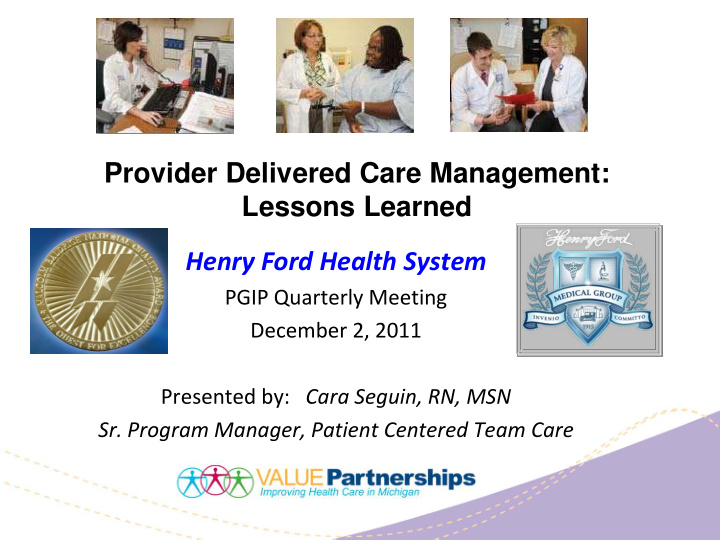



Provider Delivered Care Management: Lessons Learned Henry Ford Health System PGIP Quarterly Meeting December 2, 2011 Presented by: Cara Seguin, RN, MSN Sr. Program Manager, Patient Centered Team Care
Overview: Henry Ford Health System Henry Ford Health System , one of the country's largest, most comprehensive and integrated health care systems links together inpatient, outpatient departments, primary and secondary care, preventative care, community care services (dialysis, home health care, hospice and community retail services), a health insurance plan and acute care and speciality care, backed by excellence in research and education. Winner 2011 Malcolm Baldrige National Quality Award. HFHS includes the 1,200-member Henry Ford Medical Group, five medical/surgical and two psychiatric hospitals, over 30 primary care sites throughout southeast Michigan. Medical Home includes over 200 primary care, family practice physicians and pediatricians in 26 BCBSM PGIP-Designated Medical Center sites.
Overview: Henry Ford Health System Provider Delivered Care Management Pilot involved: > 50 Primary Care Physicians at 4 PGIP Medical Home Designated Fairlane - Dearborn Harbortown - Detroit Medical Centers: Detroit Internal Medicine- Campus of Henry Ford Hospital Taylor Harbortown Sterling Heights Columbus Center - Novi Troy Fairlane 2012- Spread CM to all 26 Medical Ctrs. Woodhaven
Patient-Centered Team Care (PC-TC) Ambulatory RN Case Management Model for High-risk Patients Patients with chronic disease- DM, COPD, Depression, Asthma, HTN, CKD, CAD, HF Patients with disease process and self-management knowledge deficits that significantly impact health Patients with social or economic difficulties that impact health Patients with frequent ED/Urgent Care visits Patients with multiple hospital admissions
Staffing Model Registered Nurse Case Managers Part of the Primary Care Clinic team which includes; physicians, residents, nurse practitioners, registered nurses, medical assistants, clinic service representatives, clinical pharmacists, diabetes educators, dieticians and administrative assistants Case Manager (CM) credentials- RN with minimum (3) three years of nursing experience; strong problem-solving, analytical and decision making skills; excellent customer service and interpersonal skills including the ability to interact with internal and external customers and all levels of the organization required Pilot sites selected based on high prevalence of chronic disease with ~ 34% total HFMG CD population covered at ~1:3500 CM to patient ratio
Case Manager Training Requirements Chronic Disease competency training online/checklist demonstration Health Coaching/Self-Management - 3-day course in Health Coaching, Stanford Chronic Disease Self-management Program, several CCM certified Lean workshops IMPACT Model: Improving Mood - Promoting Access to Collaborative Treatment Problem-Solving Therapy partnership Evidenced-based counseling technique that helps reduce depressive PCP symptoms impacting disease self-management Short-term, goal focused, empowers the patient Expands CM skill set w/applicability across all diseases they manage CM BHS
Practice Role Versus PO Role Role of the PO in the Care Management process: Primary Care Steering Committee- direct oversight in development of Patient Centered Transformation, implementation of PCTC-CM, Diabetes Care Centers, Depression Care Program, Anticoagulation RN Program, Polypharmacy Program now transformed to MiPCT Steering Committee Involved in hiring process and evaluation of CM Program oversight with monthly full-day staff meetings committed to systems approach to education, process development, documentation, performance improvement, policy and protocols, team building/networking, review of outcome metrics/performance measures, & employee engagement Role of the practice in the Care Management process: CM direct report to nursing supervisor; considered part of the clinic team “Physician-Guided Care Team Rounds” to facilitate patient care planning CM and physician meet weekly for 20-30 minutes and as needed (also as needed with other members of the team)
Lessons Learned/Barriers Acceptance of new role- what helped? Planning and preparation with sites Primary Care Development Team support Primary Care Learning Collaboratives Continuous education in large, complex system Complex data reconciliation process within an all-payer model Practice standardization and ongoing re-design- LEAN CMs became LEAN savvy and joined re-design teams No high-risk stratification process to define CM population High risk for readmission process developed later with recent enhancements of electronic medical record.
Lessons Learned/Barriers Duplicate documentation in first year was a dissatisfier until case management notes were created with EMR enhancements. Application beyond depression for problem solving therapy techniques learned CMs required to complete 13 modules and 9 audio-taped patient problem solving therapy sessions with expert critique and debriefing sessions with Impact Trainers Computer lab sessions with role play and debriefing sessions with Behavioral NP and Clinical Psychologist Review MiPCT list for certification requirements
PC-TC CM Initial Visit Documentation in EMR
Why We Think This Works…. Case Managers are located in the clinics and work closely with the physicians and clinic staff and document in the EMR. Physicians introduce the CM concept, role and value of working with a case manager to patient. Easy access to PCP to address any urgent issues. Physician-Guided Care Team Rounds to facilitate care planning CM and physician meet weekly Entire care team huddles daily Case Managers use a tele-monitoring tool with select HF patients to help manage symptoms on a daily basis Patient advisors at pilot sites provided us with valuable feedback on materials, workflow concepts, tools we use—even our name “Patient Centered Team Care” Cultural transformation seen at the practice unit level
Ambulatory RN Case Management Patient Feedback Survey
Outcome Measures Operations Measures Case load – acuity and complexity Encounters, referrals, interventions, goal setting Chronic disease competency education & check lists Clinical Improvements A1c Control LDL-C Control Utilization Reductions Inpatient Stays- Average Length of Stay (LOS) Outpatient Visits Emergency Department Visits (ED) Patient and Provider satisfaction
Additional Thoughts Need to identify patients that are most appropriate for CM – continuous reinforcement of inclusion/exclusion criteria for CM referrals Provide outcome reports and feedback to providers based on referral patterns IT support: Share data, share data again and when you think you have shared enough…share more data at practice unit level Communication in busy clinic environments is a challenge - huddles work! Physicians are looking forward to expanding CM to all HFMC sites, continued collaboration and networking through MiPCT
Recommend
More recommend